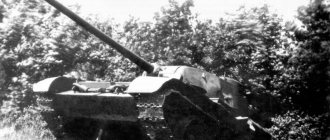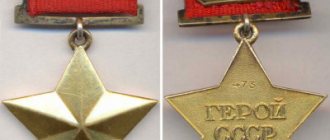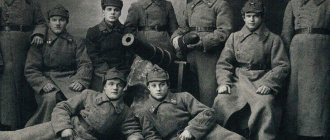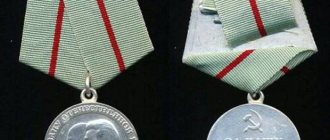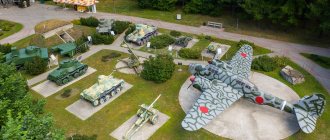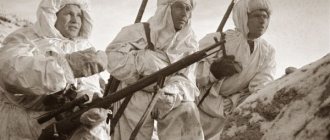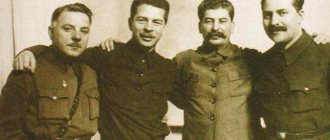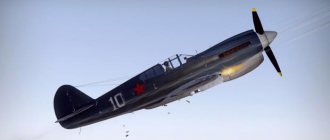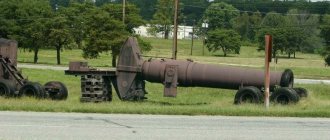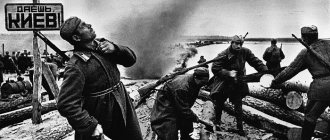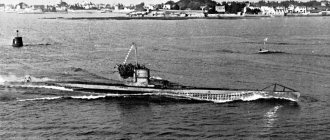Technical characteristics of the self-propelled gun "Ferdinand".
| Combat weight | 65 t |
| Length | 6.80 m |
| Width | 3.38 m |
| Height | 2.97 m |
| Crew | 6 people |
| Armament | 1x88 mm Pak-43/2 gun; |
| 1x7.92 mm machine gun | |
| Ammunition | 50 shells |
| Booking | up to 200 mm |
| Engine | 2x Maybach HL 120 TRM |
| Speed | 30 km/h |
| Power reserve | 150 km |
In the battles on the Kursk Bulge, Burda's tank brigade was in the strike zone of German troops. According to the memoirs of General M. Katukov: “According to the commander of the 49th Tank Brigade A.F. Burda, the enemy attacked continuously in their sector. There were fifty or a hundred tanks each. You hit them, and the shells ricochet off. The losses are terrible, sixty percent of the brigade.”
On January 25, 1944, when breaking through the Korsun-Shevchenko pocket, the enemy with 12 Tiger tanks reached the brigade command post in the area of the village of Tsybulev (now the village of Monastyrischensky district, Cherkasy region in Ukraine).
The best tankers - numbers and facts
Knispel - 168 victories, Schroiff - 161, Carius - 150, Belter - 139, Wittmann - 138, Oberhaber - 127, Zandrock - 123... Another 10 aces - 100-119 tanks, 44 tankers - 35-99 vehicles each... Number of German victories The tankers are no less amazed than the number of victories of their pilots. But our modesty is quite understandable.
Ivan Lyubushkin on the T-34 knocked out 9 tanks in one battle
In the cramped turret of the best Russian T-34 tank, the commander, in addition to his duties, also served as a gunner. Chained to the gun sight and occupied with the gun, he had no time to look around to protect his tank or find a new target in time. And it was on this T-34 that our tankers fought through the first and most difficult years of the Great Patriotic War.
The Germans had a gunner on absolutely all medium and heavy tanks, and the commander only monitored the battle and gave orders. Therefore, the Germans always had a chance to be the first to detect the enemy and get ahead of him in the shot. And so they fought not for three, but for six whole years (1939-1945) - a lot of experience.
The French, British, Russians and Americans had more tanks, meaning more targets for the Germans and, as a result, more opportunities for victories. And ten Allied tanks were opposed by only one German. As a result, one German could hit several (or even all 10), and the Allies could hit only one (that is, nine of them did not hit anyone at all).
In addition, we awarded money for destroyed tanks, so the commander, the head of the financial unit and the auditor very strictly monitored the confirmation of victories.
On the KV, Semyon Konovalov, in a battle with 50 enemy tanks, knocked out 16 of them
Using the T-34-85, the young (19 years old!) tanker Ion Degen knocked out 16 tanks and fire control systems in less than a year of war. Alexander Oskin, using the same vehicle, destroyed 3 Königstigers in just one battle!
Using a 1943 T-34, Grigory Brazhnikov knocked out 4 Tigers in one battle.
Using a BT-7, Grigory Naidin knocked out 15 tanks in one battle
Since 1943, the Germans only defended themselves - they attacked while standing still and from ambushes, which was ideal for high results. The attackers shot on the move (at nowhere), and for an aimed shot they had to stop (becoming an ideal target). In the famous battle of Prokhorovka, our entire tank army was killed in this way...
During the last two years of the war, all German tanks had guns with long barrels; ours only had guns for the last six months. Therefore, for a long time, the Nazis shot our tanks with impunity from distances beyond our reach.
Most of the German aces fought all six years of the war, and ours fought for at most a year or two.
Taking into account the above, the price of victories for Soviet tankers increases sharply. And the names and numbers are as follows: Dmitry Lavrinenko - 52 tanks (died in 1941), Vladimir Bochkovsky - 36, Mikhail Kuchenkov - 32, Nikita Dyachenko -
31, Nikolai Moiseev - 31, Konstantin Samokhin - 30 (died in 1942), Alexander Burda - 30 (died in 1944), Nikolai Novitsky - 29. And this is not a complete list of Soviet heroes.
On the Panzer IV, Rudolf von Ribbentrop shot 14 T-34 tanks during the battle near Prokhorovka
Ernst Barkman knocked out 82 tanks on the Panther
On the Panzer IV, Rudolf von Ribbentrop shot 14 T-34 tanks during the battle near Prokhorovka.
The vast majority of German aces fought on the Tigers. The most famous of them is Michael Wittmann. He became most famous on June 13, 1944, when he crashed into a column of British tanks and, moving along it, hit 21 Shermans in a matter of minutes. In the French village of Villers-Bocage, his tank was hit. But Wittmann did not leave the car, but continued the battle, shooting all the enemy tanks within the limit of his visibility. He died on August 8, 1944 in a battle with Canadian tanks.
The most successful tanker of the Second World War, 23-year-old sergeant major Kurt Knispel, took his last battle on the Königstiger (Royal Tiger). He has 168 confirmed victories (126 as a gunner, 42 as a tank commander). He had more than 20 unconfirmed victories, but he never chased the score and did not argue when applications for a damaged tank were rejected. From 1940 to 1945, Knispel fought on all German tanks except the Panther. He was nominated for the Knight's Cross four times, but never received the award due to his overly independent character. He hated injustice and, without hesitation, stood up for a Russian prisoner who was being abused by an SS officer. Most likely, a shot from an SU-100, commanded by junior lieutenant Sheiko, put an end to his career. Knispel's tank was hit, and the German hero died from his wounds in the hospital.
Share link
Ambush company
The crew of the KV-1 tank, senior lieutenant Kolobanov, included gun commander senior sergeant Andrei Usov, senior mechanic-driver foreman Nikolai Nikiforov, junior mechanic-driver Red Army soldier Nikolai Rodnikov and gunner-radio operator senior sergeant Pavel Kiselkov.
The crew was a match for their commander: well-trained people, with combat experience and a cool head. In general, in this case, the advantages of the KV-1 were multiplied by the advantages of its crew.
Having received the order, Kolobanov set a combat mission: to stop enemy tanks, so two ammunition loads of armor-piercing shells were loaded into each of the company’s five vehicles.
Arriving on the same day at a place not far from the Voyskovitsa state farm, Senior Lieutenant Kolobanov distributed his forces. The tanks of Lieutenant Evdokimenko and Junior Lieutenant Degtyar took up defense on the Luzhskoye Highway, the tanks of Junior Lieutenant Sergeev and Junior Lieutenant Lastochkin covered the Kingisepp road. Kolobanov himself received the coastal road located in the center of the defense.
Kolobanov’s crew set up a tank trench 300 meters from the intersection, intending to fire at the enemy “head-on”.
The night of August 20 passed in anxious anticipation. Around noon, the Germans tried to break through along the Luga Highway, but the crews of Evdokimenko and Degtyar, knocking out five tanks and three armored personnel carriers, forced the enemy to turn back.
Two hours later, German reconnaissance motorcyclists drove past the position of Senior Lieutenant Kolobanov’s tank. The camouflaged KV-1 did not reveal itself.
Foreign and Russian films of past years
Four tankmen and a dog (TV series, 1966-1970)
The Polish television series, based on the work of the same name by J. Przymanowski, tells about the everyday life of the crew of the Red tank. The tankers and the dog Sharik end up in different stories, but they always come out with honor. The series, intended for children and youth, was shown on Polish television every year until 1989.
- Please note : The best TV series about the Great Patriotic War
Trailer
Original title : Czterej pancerni i pies Actors : Janusz Gajos, Franciszek Pieczka, Wlodzimierz Press, Małgorzata Niemirska... Country : Poland Rating : Kinopoisk – 8.2, IMDb – 7.8 Age restrictions : 6+
Sahara (1995)
An interesting film about American tank crews directed by B. Trenchard-Smith is a remake of the 1943 film of the same name. The action takes place in the hot summer of 1942 in North Africa. Joe Gunn's tank is the only one to survive the fierce battle. Having picked up several soldiers, the tankers drive the vehicle into the sands in the hope of finding water.
Trailer
Original title : Sahara Actors : James Belushi, Alan David Lee, Simon Westaway... Country : Australia, USA Rating : Kinopoisk – 7.3, IMDb – 6.8 Age restrictions : 12+
Kelly's Heroes (1970)
In this non-standard war movie about tanks, events unfold in France in 1944, during the period of liberation of the territory from the Nazis. According to information received from a prisoner of war, Sergeant Kelly learns about a stock of gold in a bank in one town. The sergeant gathers a motley crew and goes in search of treasure deep behind enemy lines.
- We recommend watching : 20 war films about intelligence officers
Trailer
Original title : Kelly's Heroes Actors : Clint Eastwood, Telly Savalas, Don Rickles... Country : USA Rating : Kinopoisk – 7.1, IMDb – 7.6 Age restrictions : 12+
View on ivi.ru
Battle of the Bulge (1965)
The war film by American director K. Annakin tells about the Battle of the Bulge, which took place in 1944-1945. The film was nominated for a Golden Globe Award. The command of the German troops is preparing a counter-offensive with the help of a secret tank division. To ensure the success of the operation, Colonel Hessler decides to seize fuel from a small detachment of allies.
Trailer
Original title : Battle of the Bulge Actors : Henry Fonda, Robert Shaw, Robert Ryan... Country : USA Rating : Kinopoisk – 6.2, IMDb – 6.8 Age restrictions : 12+
Purgatory (1997)
The drama about the first Chechen war was filmed in the modern pseudo-documentary genre. There are a lot of brutal scenes of violence and intense fighting. Russian soldiers occupy a hospital complex in Grozny under the command of a wounded colonel. He begins negotiations with the Chechen commander.
- Selection on the topic : 20 feature films about the Chechen war
Trailer
Actors : Victor Stepanov, Dmitry Nagiyev, Vyacheslav Burlachko... Country : Russia Rating : Kinopoisk – 7.8, IMDb – 7.0 Age restrictions : 16+
Beast (1988)
An American film about a tank, based on the play by W. Mastrosimone, is dedicated to the war in Afghanistan. A Soviet tank is surrounded in the desert. The team's attempts to break through to their own end in failure. After a conflict with the commander, one of the tankers is left abandoned to certain death.
- Similar selection: 22 films about the war in Afghanistan
Trailer
Original title : The Beast of War Actors : George Dzundza, Jason Patrick, Steven Bauer... Country : USA Rating : Kinopoisk – 6.1, IMDb – 7.3 Age restrictions : 16+
Unofficial hero
At the beginning of September 1941, all members of Zinoviy Kolobanov’s crew were nominated for the title of Hero of the Soviet Union. But the high command did not consider that the tank crews’ feat deserved such high praise. Zinovy Kolobanov was awarded the Order of the Red Banner, Andrei Usov was awarded the Order of Lenin, Nikolai Nikiforov was awarded the Order of the Red Banner, and Nikolai Rodnikov and Pavel Kiselkov were awarded the Order of the Red Star.
For three more weeks after the battle near Voyskovitsy, the company of Senior Lieutenant Kolobanov held back the Germans on the approaches to Krasnogvardeysk, and then covered the withdrawal of units to Pushkin.
On September 15, 1941, in Pushkin, while refueling a tank and loading ammunition, a German shell exploded next to Zinovy Kolobanov’s KV-1. The senior lieutenant was very seriously wounded with injuries to the head and spine. The war was over for him.
But in the summer of 1945, having recovered from injury, Zinoviy Kolobanov returned to duty. He served in the army for another thirteen years, retiring with the rank of lieutenant colonel, then lived and worked in Minsk for many years.
A strange incident occurred with the main feat of Zinovy Kolobanov and his crew - they simply refused to believe in it, despite the fact that the fact of the battle near Voyskovitsy and its results were officially documented.
It seems that the authorities were embarrassed by the fact that in the summer of 1941, Soviet tank crews could so brutally defeat the Nazis. Such exploits did not fit into the generally accepted picture of the first months of the war.
But here’s an interesting point: in the early 1980s, it was decided to erect a monument at the site of the battle near Voyskovitsy. Zinovy Kolobanov wrote a letter to the USSR Minister of Defense Dmitry Ustinov with a request to allocate a tank for installation on a pedestal, and the tank was allocated, although not the KV-1, but the later IS-2.
However, the very fact that the minister granted Kolobanov’s request suggests that he knew about the tank hero and did not question his feat.

